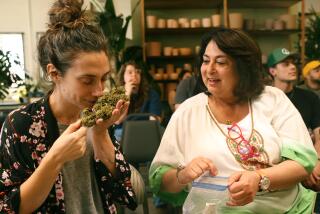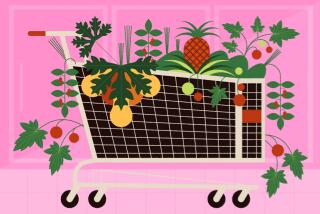The Good Seed
- Share via
My garden is doing something to me. What I once considered rich is now dreary, bright has become brash, and the acceptable has turned boring. I am puzzled; my neighbors’ sprightly gardens still speak eloquently for them, but for me, yellow and orange calendulas, maroon pansies, skimpy sweet peas, scentless stock, even the blue violas, stir a silent command: “Change!”
My response: In a quest for plants that are new, I shall plant seed. By selection and with timing, I will easily have a plant palette with which no local nursery can compete.
Now is the time to start seeds for fall--our second spring. Generally, cool-weather annuals that are begun mid- to late August establish their root systems and bloom before the days get too short, then continue throughout the winter.
A quick and inexpensive way to propagate seeds is to use a method that was taught by the late Duane O. Crummett Ph.D., teacher of horticulture at UCLA Extension. The materials consist of a coarse No. 2 grade of vermiculite, available at nurseries or building-supply stores, and clean four-inch-square plastic plant containers, which most gardeners have in overabundance.
Begin by filling the containers to within a quarter-inch of the top with dry vermiculite, and space 16 seeds evenly across the surface. Settle them so that they have good contact with the mix, and saturate the vermiculite by spraying it gently until the water runs out the bottom. Heap dry vermiculite on the moistened surface to cover the seeds, and level off the surplus with the edge of a ruler. If the seeds you are using require light to germinate, omit the final covering, taking care, always, to avoid packing down the vermiculite; the roots need air space to develop. Spray the top again with water; from then on, maintain the moisture content by watering from the bottom.
For greenhouse seed propagation--if transplanting might be delayed--Crummett added a one-quarter-strength solution of a balanced water-soluble fertilizer when he watered the top layer. That way, nutrients would be there when the germinated seed passed out of the cotyledon into the true leaf stage.
For young plants grown in vermiculite, to condition them to soil, tip the container and remove the contents. Then slowly lift each plantlet by the leaf, coddling the delicate root hairs. Place each one into an individual container, and cover the fibrous roots with moistened soil. Gradually move the new plants into the sunlight and finally to their garden location.
Another way to get healthy plants from seed is to use the Accelerated Propagation System, called APS. The unit, made in England, is an easily handled, reusable, enclosed, self-watering set that is not much bigger than a shoe box.
APS sets come with either 40 1 1/2-inch or 24 2-inch cells and cost $7.95 each from the Gardener’s Supply Co., 128 Intervale Road, Burlington, Vt. 05401. A germinating mix also is available, at $3.50 for nine quarts, which will fill three APS units.
For seeds that like cool temperatures, place the APS in a cool place--under a bed, for instance. The APS makes stratification easier for seeds that require moist chilling to activate germination. My alpine primula seeds spent an artificial winter in my freezer, and a spinach-sown unit sits now in my refrigerator.
A hermetically sealed, waterproof heating cable is indispensable for seeds that prefer warmer conditions. Mine, preset to 74 degrees Fahrenheit, is set up indoors, and sunlight is simulated by four 20-watt fluorescent bulbs; two warm white and two cool white.
The lines of the cable are spaced three inches apart in parallel lines and secured by electrical tape to the bottom of a large baking tray. Small aquarium pebbles are spread to a depth of about an inch atop the taped lines and diffuse a thin layer of water into humidity. The heating cable, available through Park Seed Co., comes in three lengths; the shortest is three feet long and costs $4.50. Request a catalogue from Park Seed, Highway 254 North, Greenwood, S.C. 29647. I have looked to the catalogues for my own seeds. In my fall and winter garden this year, I anticipate ‘Imperial Pink’ and ‘Raspberry Rose’ pansies from Thompson & Morgan as well as their ‘Romanesco’ broccoli, which has heads that grow like clusters of jeweled brocade. Their catalogue is free; write to them at P.O. Box 1308, Jackson, N.J. 08527. And then there’s the Country Garden, which offers a refreshing collection of flowers for cutting that defies the trend toward dwarf plants. From them I’m requesting seeds for Pacific Beauty calendulas in apricot and lemon yellow; a mix of Spencer-type sweet peas and a separate packet of some in ‘Geranium Pink Improved’ to help my dreams of Gertrude Jekyll-styled bouquets that combine sweet peas with roses. Then, for supper-table flowers, I’m also including powerfully scented evening stock ( Matthiola longipetala bicornis ) and some blue Nigella of the strain that bears Miss Jekyll’s name. Did that venerable lady gardener also smile, I wonder, at its common name, love-in-a-mist? The Country Garden’s address is Route 2, Crivitz, Wis. 54114 ; their seed price list is free, and the informative catalogue costs $2.






